Canelés de Bordeaux
by mimithorisson
My heart fills with joy when I see March appear in my precious diary. This month marks the arrival of spring in Médoc, with pretty flowers blossoming on trees everywhere. If I had to match a painting to this month, it would be Gustav Klimt’s ‘Mäda Primavesi‘. The girl, the dress, the flowers – that’s March for me. When I lived in Paris, I would go to the Jardin du Palais Royal almost everyday in March to see if the magnolia trees had blossomed. I consider it to be my birthday flower, and when I see the first flowers bloom it’s just like a blessing for a new year in my life. It’s just one of those euphoric things, when you appreciate everything associated with spring and the possibilites are endless. Where flowers bloom so does hope.
One of the new-found joys of country life must be the flowers. Back in Paris, we were so lucky to live just by the market of rue Cler in the 7th arrondissement, where we would buy our dose of flowers at the local florist, and extra special bouquets at the extraordinary Eric Chauvin. My kind of heaven consists of fluffy bouquets of peonies, sweetpeas and ranunculus. Now that we have become country folks, nothing can compare to the excitement of picking the most beautifully scented roses from our own garden and the surroundings. Wild cyclamens, daffodils, violets. I could go on and on. But the most exciting bouquets this month are branches from plum and magnolia trees. The combination of taupe brown wood with warm beigy pinks are exactly the kind of colors I would pick for my dream room.
The flowers just started to bloom this week, so you can imagine my level of happiness. Bright confetti petals exploding everywhere. My heart goes boum whenever I see un arbre heureux (happy tree). That’s how my kids call them – every blooming tree is a happy tree! Let’s celebrate!
We are all admiring our latest flowers. I want to paint them so they will last forever. To accompany such a beautiful moment, I baked canelés. These little custardy cakes with a caramelized crust are a local delicacy, flavoured with vanilla beans and rum. Croustillants (crusty) outside and moelleux (soft) inside, each bite is pure pleasure. Canelés have a mysterious past, originating from Bordeaux. Traditionally , Bordeaux wines were clarified with egg whites, a vinification step called collage, leaving the yolk for cooking. Chateaux owners would give the egg yolks to local convents where the nuns conjured up their confections. This could have been the start of the canelés. They were apparently influenced by a cake called ‘canole’ made by bakers in Limoges and very popular in Bordeaux. I personally think that all of the above, as well as the influence of vanilla beans and exotic rum arriving at the port of Bordeaux all contributed to the legendary canelés.
When you buy them, you are always asked if you prefer a canelé bien cuit (well-cooked, more caramelized) or moelleux (more chewy). It’s really a matter of personal taste. I like them moelleux, to be exact, 55 minutes in the oven. The batter is as simple as it gets, then left 24 hours in the refrigerator. Let the batter have a good rest and develop all the right texture and taste, then it’s 55 minutes in the oven, not more not less. The only thing you have to do is lower the temperature after 5 minutes, and voila. Here are my tips: I use silicone moulds, I don’t line the moulds with butter because, in my opinion, it encourages the canelés to get crusty too fast. For those who prefer a more caramelized crust, you can bake them for 10 minutes longer.
Canelés are enjoyable any time of the day, as a tea time snack, as dessert, preferably with a sweet white wine, like a Bordeaux Sauternes or a Loupiac or at the end of the meal with coffee. I am always in the mood for a canelé, if I have some left I’ll even have them for breakfast with my morning cup of Yorkshire tea. A canelé is always appropriate, especially here in Bordeaux.
Ingredients: (makes about 16 canelés)
You will need a canelés mould (I use silicone moulds).
500 ml/ 2 cups and 1&1/2 tbsp full cream milk
120 g/ 1 cup plain flour (sifted)
200 g/ 1 cup granulated sugar
3 egg yolks
1 vanilla bean, split lengthwise
60 ml/ 1/4 cup rum
30 g/ 2 tbsp butter (melted)
In a medium saucepan, combine seeds from vanilla bean and milk, mix well – bring to a boil and set aside for 5 minutes. Whisk in sugar and sifted flour, mix well to avoid any lumps (if there are too many lumps, simply strain batter through a sieve). Add egg yolks, one by one, gently mix. Add melted butter, stir. Finally, add the rum and whisk batter until smooth. The batter should be similar to a crèpes/ pancake batter – not too thick, not too thin.
When batter has cooled down, cover and place in the refrigerator for at least 24 hours.
I use silicone moulds and I don’t line the moulds with butter. Fill canelés molds 2/3 of the way. Bake in a preheated oven 230°C/ 450°F for exactly 5 minutes, then lower temperature to 180°C/ 350°F and bake for an additional 50 minutes. Take out of the oven, leave canelés in molds for 5 minutes, then unmould them. Place on a wire rack and leave to cool.

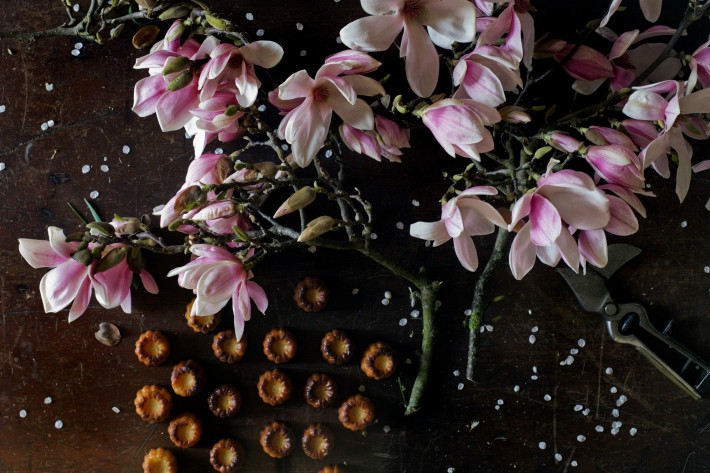
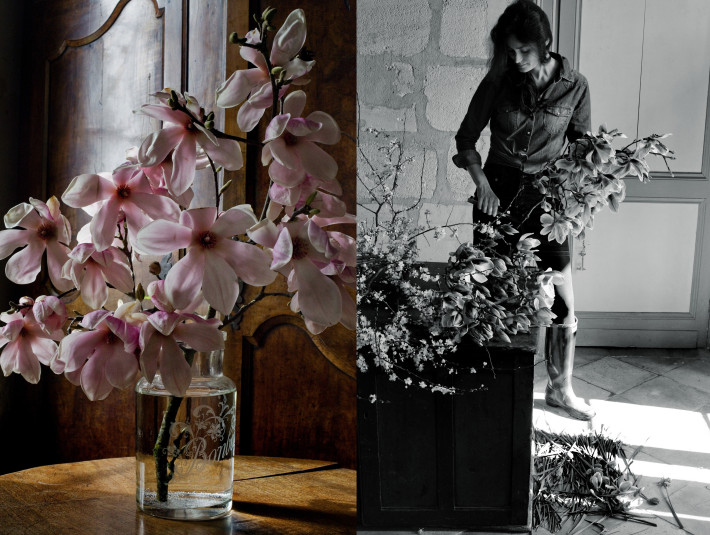

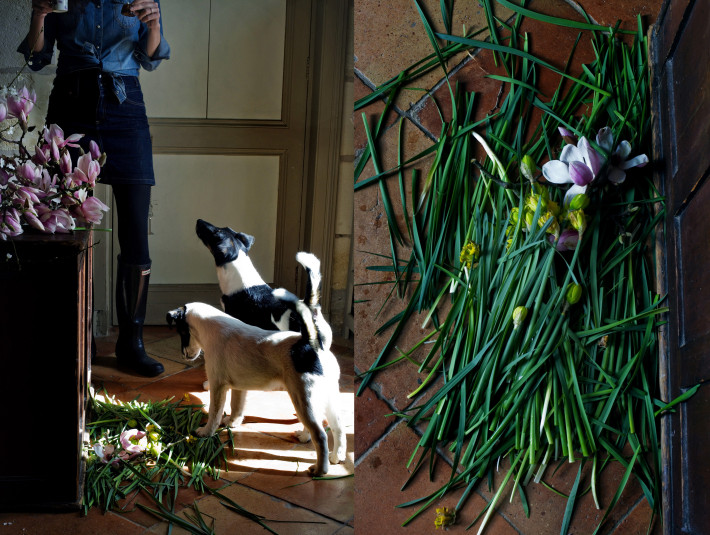
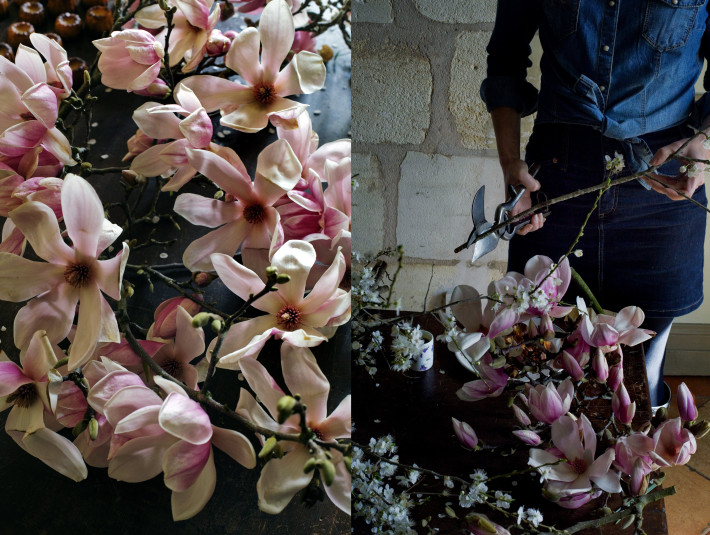

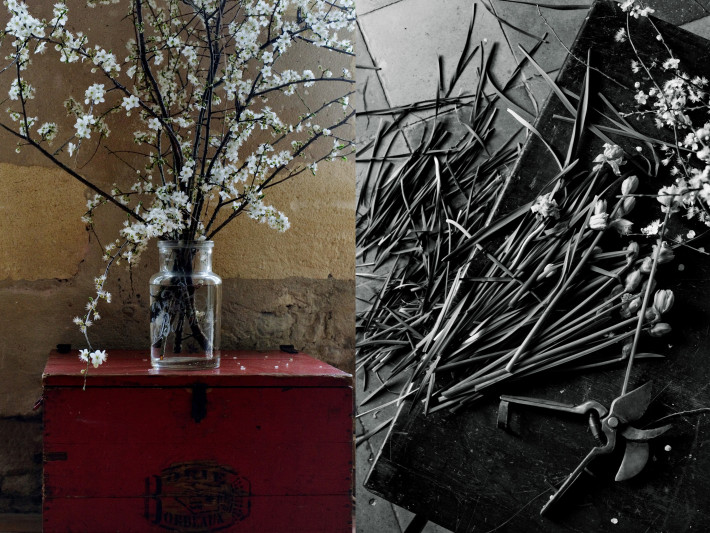
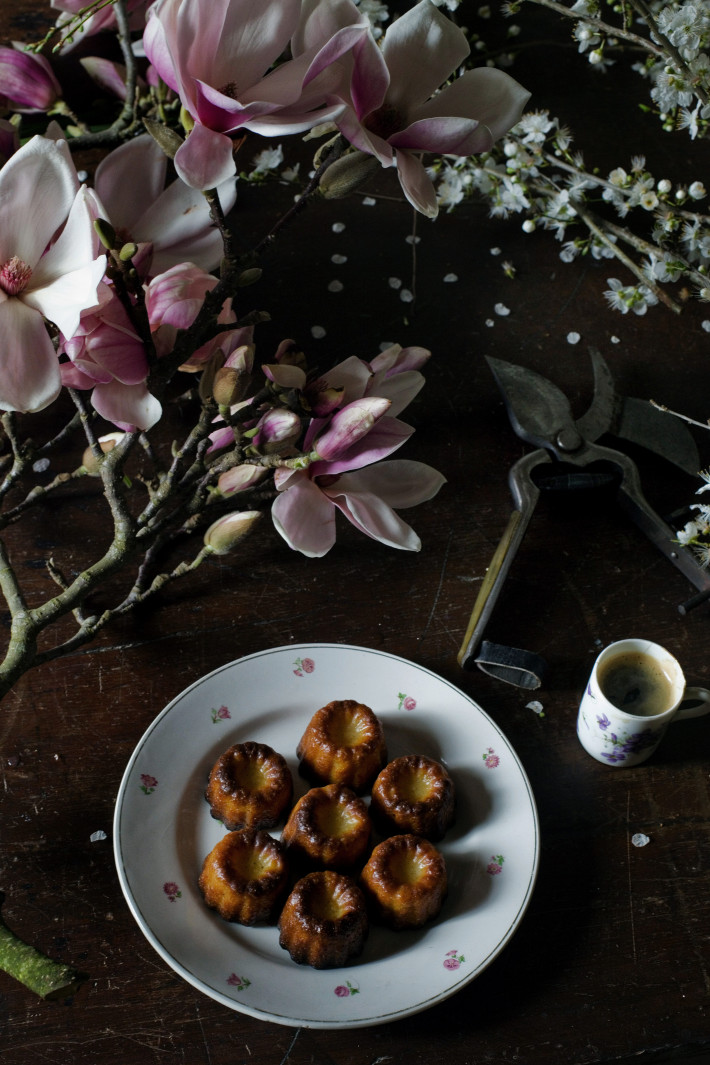
Such beautiful, dreamy and romantic images!
Thank you for setting me off for the day full of joy. Will try the recipe–will improvise the molds. Have a wonderful loving Sunday.
Mary
You are welcome Mary! Enjoy the recipe! Have a lovely Sunday.Mimix
Hi! I’m italian,and I love your recipes. Last week I made your “tarte au chocolat” and my family said that it was gorgeous. So, thank you. For your all recipes and for the beautiful images.
Alice.
Bonsoir from Médoc! So happy to hear this. Wishing you a lovely Sunday! Enjoy the recipes. Mimix
Oh my! How lovely. We are still about three weeks away from flower season. I can’t wait!
Wonderful photos and recipe. What size are your finished caneles? I’ve found molds in multiple sizes and I assume that influences the baking time. Thanks.
Bonsoir Tatiana! The canelés moulds are 5 cm/ 1.9 inches height and 5 cm/ 1.9inches width. I fill them up 2/3 of the way. Hope this helps! Mimix
Merci beaucoup! It helps very much.
Beautiful, Mimi! I hope to soon see bouquets with ranunculus’ and peonies, but that won’t be until the summer probably. Gorgeous!
Your photos are so beautiful and the canelés sound delicious!
Does the melted butter go in the batter when the rum is added or is the butter optional to grease the molds.
I recently discovered these little bites of heaven at a French bakery in San Francisco and wished for a good recipe and have just ordered a silicone mold on line. Merci beaucoup, Mimi. I look forward to Manger with relish.
Bonsoir Jan! The melted cooled butter goes in the batter just before the rum. I don’t butter the molds (I use silicone molds) because, from my experience, buttering the molds accentuates the browning and they have a tendency to caramelize faster. The canelés are just how I like them. Wishing you a lovely Sunday. Mimix
Bonjour Mimi,
Daffodils last week…magnolias this week…Spring has sprung in the Medoc. I remember seeing copper caneles moulds in a store in Paris. I wanted to buy them just for looking at…but silicone moulds are so much easier to work with. Caneles et cafe une dellicieuse gaterie. Merci Mimi. Anita
Bonsoir Anita! Yes, spring has definitely sprung – we are loving the floral bliss at home – the sweet smell of the plum flowers is so uplifting! I agree, copper moulds are just so good-looking, but silicone works best for me. I don’t grease the moulds with butter – just batter and voila! I just love canelés. They are also perfect gifts for friends! Bisous Mimix
Your springtime flowers are beautiful! We still have a month or more of winter here in Colorado, and I’m dying to see the trees bloom again! There’s a double flowering plum in my garden which always blooms around my daughter’s birthday. That’s when spring begins for me. Have a very happy birthday, whenever it may be 😉 ~Rebecca
Thank you Rebecca! I am so touched by the beauty around me – what a lovely gift from nature! Wishing you a happy spring! Mimix
These are too dangerous for me Mimi… they are my absolute favourites… I love canalés far, far too much… 🙂
As for the magnolias and the blossoms… you can probably near me sighing from here… As ever beautiful images… xv
Oh thank you Vicki! It’s a pleasure to share such beauty. I am loving the flowers, the scent, the feeling – spring is happening as we speak. It must be lovely in Provence too, no? Made about sixty canelés this week-end – all gone:) Mimix
Bonjour Mimi, I’ve been reading and following your blog for awhile now but this post was just too good to not comment on. Reading every word of this made me so happy— I shared in all the joy and excitement of spring that you put very beautifully and simply into words.
Also! A few weeks ago I made your Far Breton— wonderful!
Thank you! So happy to hear you enjoyed the far breton – I always enjoy this recipe. Have a lovely week! Mimix
Just lovely….and delicious too! Thanks so much for sharing.
I love your pictures!!!
So beautiful..
Wishing you a lovely sunday, Marie
You too! Thank you! Mimix
Beautiful imagery, overall!! I can not wait to try this recipe! Need some Parisian inspiration here in the very urban Bay Area, California!
WOW-
… i am remembering when we were living in Sicily-
Today it was snowing *brrrrrrr (we are living on the north coast of Germany)
Wish you, your family, your dogs, … the best spring start!
xxx Aileen
Thank you! Ah! Sicily – what wonderful memories you must have! Wishing you a happy spring! Mimix
Wonderful photography and still I love your writing the most… Your love for nature’s beauty and especially your obsession concerning interesting recipes… Thank you once more for sharing!!!
Merci beaucoup for allyour kind workds! It’s so encouraging to hera you enjoy the writing – it’s so wonderful to be able to share my joy and passion on life’s simple pleasures:) I hope you will try this recipe – it’s such a special treat. Wishing you a happy spring, Mimix
You are so welcome!!! I admire your daily cooking and baking, as I do know how life feels like with so many children – like you and Oddur me and Wolfgang are struggling every day to get everyting done… And then, it is such a pleasure to see that the children are developing a strong sense of ‘good meals’… And all our efforts then do make sense and we again know why we are doing all this! Special greetings from mother of six to mother of six… 🙂
I love the pink magnolia trees! My favorite part of spring, here in Northern California!
I love reading your blog, your posts make my days Mimi, Thank you. Amazingly gorgeous flowers and bouquets. The desserts look delcious love the recipe.
I love spring and the blossoms on trees. I am traveling around the 28th of this month with my hubby to Tokyo, Japan the Peninsulla hotel, I can’t wait to see the cherry blossom season. Is your birthday around this time of the year? Best wishes xo
Thank you Rowaida! Enjoy the cherry blossoms in Japan – they are so beautiful. I have been in the past – an unforgettable sight 🙂 Yes, my birthday is end of March – it’s always a happy month (also my son’s birthday!). Bon voyage! Mimix
Magnolia trees truely welcome spring with the earliest of blooms! Did you know Magnolia is an ancient genus, appearing long before bees did (Cretaceous, Dinosaur Era). The white ‘petals’ are in fact specialized leaves. The real (and many) flowers are inside.
Canelés are sooo good, but were always a mystery to me, until now.. thanks for sharing!
We have to wait some time yet, here in West Central Canada. Lots of snow! Beautiful pics and I have been wanting to make caneles.
Stunning as always. And I love that you mentioned a painting this time (Klimt), as I always think your blog photos are paintings in themselves. As your readers, we are so lucky that you have attached such beautiful imagery to your lovely words and recipes.
On the other side of the world here in Sydney we are entering Autumn. I took my teenager daughters apple picking in the mountains on the weekend, we made apple pie using your shortcrust recipe, it tasted divine.
I too love Magnolia blossoms and have a lovely florist that sources them for my workplace!
Looking forward to making canalés,have just orderd a silicone mould. Im sure these will be a hit, especially with my daughters French class at school.
Thank you for the inspiration x
I adore caneles. I can’t believe they are so simple to make. I may just have to invest in some molds, I think!
How perfectly timely! I JUST received my silicone canele mold two days ago and have been hunting the web for the perfect recipe! Your pictures took my breath away – definitely one (of many!) of my favorite posts to date. Can’t wait to see what you come up with next!
Beautiful images! This is what I miss the most in HK – European spring when the fruit trees and flowers are blossoming.
That picture of you and two dogs is wonderful. One dog, it seems, is interested of what you’re eating and the other one likes the flowers on the floor 🙂
This post makes me so happy. 🙂 It is so lovely to experience Spring through your home as I enter Autumn in mine. I’m so glad you have gorgeous blossoms to cheer your heart. 🙂
What beautiful photos! It must be so nice to have spring come already. Here in northern Germany, just as we all thought that Spring was surely on the way, we were presented with a last minute snow. I think these canalés are just what I need to perk me up! One question: you say 500ml or 1Cup milk – but 500ml is 2 cups???
Good morning Masha! Yes of course thanks for pointing this out – obviously 500 ml is 2 cups + 1 and a half tbsp – I immediately updated it on the post. Hoping spring comes earlyto Germany 🙂 Best, Mimix
Thanks for the clarification Mimi and the wishes for an early Spring – today I had to shovel snow again :o( But I will sit in front of the warm crackling fire and eat these wonderful canales and not think of the weather outside!
Ha! Should have guessed such poetic and romantic writings were coming from a fellow Yorkshire tea drinker, branch lover and born in March too! I consider the daffodil to be my birthday flower, it marks St David’s day…Will definitely try this recipe when I find the correct moulds, it looks very simple. I have sweet memories of tasting canelés wandering around Bordeaux as a young au-pair…thank you x
Good morning Elizabeth. Nice to hear you are a Yorkshire tea lover too, I can’t start the day without a good cup (and marmite on toast)! I always buy mine at WH Smith in Paris. It’s a bit of a sacrilège that I prefer silicone moulds more than the classic copper ones, they are so incredibly beautiful. But sometimes it’s best to be practical and use the one that works best. I don’t butter the moulds and the results are perfect. I hope you’ll enjoy this recipe:) Have a lovely snowy day – must be beautiful. Mimix
PS. so much for Spring, we have thick snow in Normandy!
Ah, ces petits merveilles me font grand plaîsir!
Joli blog, Madame! Anita
Love this post, so tasteful and lovely.
Hope for spring, thank’s
Anna
canelés and flowers! my two favorite things! such a refreshing combination, perfect for spring!
Mimi, those magnolia blossoms are beautiful. Our daffodils have just started growing!
Totally inspiring.
Any suggestions for rum substitute as we don’t consume alcohol?
Also I did bake the date cake with the wonderful glaze…wow! so easy and that glaze….: )
Can’t wait to try this one next, and then the Persian love cake…I am sure a book is in the horizon for you…
with much fondness,
a happy and inspired reader!
Bonsoir Valérie! So happy to hear you enjoyed the date cake. I would suggest trying orange blossom water (fleur d’oranger) instead of rum. You can also try adding one more vanilla pod so the the vanilla taste will be more intense. Enjoy the recipe! Mimix
I thought they were ITALIAN!Thanks for the input.Your flowering trees are MAGNIFICENT!You are MAGNIFICENT!
I am so happy that I found your blog. You are living a life of my dream. Thank you for letting us be a part of it. Photography is outstanding, please say hello from us to your husband. My husband and I are wishing you the best! Hugs from Pennsylvania US.
Yelena
Mimi, magnificent pictures! And I love les caneles. One question: is thee a way to make them less caloric? instead of butter, could you possibly suggest another product? Here in the villages around Cannes, I learned many sweet stuff recipes that use olive oil… Would it work?
Thank you so much!
Hello! I think olive oil would work – I admit I have never tried before, but I have baked cake with vegetable or oilive oil the cakes are lovely! So why don’t you try? Would love to hear how it went! Bonne journée, Mimix
Thank you so much! Will give it a try this weekend!
Bonne nuit,m.
Those look so decadent…I just ordered canelé molds…can’t wait to make this recipe! Thanks for sharing.
Mimi, I stopped by by way of Tina’s post. I was happily surprised to see your canele recipe. I received a silicone mold for Christmas and was wondering how to use it. Mine just came out of the oven and they are beauties. My mold is mini, about 1 1/4″. Anyway, thank you and I look forward to your blog. PS. I also rec’d a brioche pan……..:) Valerie D
Hi there
I used your blog as one of the inspirational blogs for mine. After being encouraged by so manycity friends I have started my own blog. I live a parallel life to yours: I also live rurally but I am on a remote sheep station in the African desert, I have three kids but older than yours and I also love March as autumn sets in so the garden is in full flower. See my blog on http://www.karoolavenderfields.com if you wish! PS: Wish I shared your love of cooking though! AM
Absolutely beautiful..I will have to add a Magnolia tree to my list!
Your photos are amazing- so glad to have found you too!
Magnolias are among my favorite flowers. The branches of the tree are somewhat rustic but the flowers have a simple elegance and color and they bear the promise of spring. Beautiful post!
Such stunning photos and lovely caneles. I do slightly envy the early Spring in Medoc, here in the Netherlands temperatures have been swaying between sunshine at +15 and snow storms at -7, the poor plants got completely confused!
I followed your recipe to the letter, but my batter – after 24hours – turned out runny with a skin! What can you do?? despair!
Bonjour Ilse! Your batter is supposed to be runny like a crèpe batter, so no worries there. The skin is probably a result of the butter hardening (all butters are different). Just whisk the batter and pour into the moulds. I am sure your canelés will turn out great! Wishing you a happy baking day! Mimix
Hallo again, Mimi – could you tell me also if the baking temperature you gave is fan-assisted or just upper and lower heat? They burned to a cinder. I will try again, though. Thank You!
Oh dear you really are not having much luck! It must be a temperature issue, did you lower the temperature after 5 minutes to 180°C? My oven is upper/lower heat, an old oven that works perfectly well for me. I bake canelés regularly. My best tip would be to check them regularly after 35 minutes of baking. I really wish you all the best Ilse. Mimix
Your website is absolutely amazing! I can’t remember how I cam across it. But I love it.
The pictures, writing, and the sentiments evoked . . . all take me away from a busy urban life. And remind me of a piece of serenity that can still be found, somewhere.
Keep writing. Keep taking pictures. I’ll keep checking your blog.
Thank you.
I’ve recently become obsessed with pretty flowers so this post is like a dream to me! I’m very fond of French cooking.. will definitely try out that recipe sometime!
Hi Mimi such gorgeous pics and I love how you write with such passion and weave your beautiful recipes in with them. I would be in heaven surrounded with all those blooms the magnolia tree is beyond my wildest dreams..adore the kids description xx Carla
Wow, these are delicious and easy to make! I’ve made a number of batches over the past week and have loved sharing them with family and friends- all have been delighted! Thanks for sharing this recipe and for all the inspiration you pass along through your blog.
so nice pictures! your blog really express the joy of living and good delicious food!
Such a beautiful, inspiring post as usual 🙂
What a delicious discovery, your site. And how I love a good canele. Funny thing is I had my first one not in Paris or Seattle, but in Yakima, Washington, at the farmers market. After filling up on some amazing pancit for lunch, I’d waddle on down to the bakery stall with the caneles. Ummm…cultural and culinary heaven. Thanks for sharing your spirited adventures and recipes. I’m a man who is always in line for a baked good, and your offerings here should keep me pretty busy in the kitchen. Merci!
my caneles are in the oven now…I am sure they will be delicious. We spend our summers in Beaune and winters in
Virginia. Your Blog helps me during the long winters to remember the beauty that is France…Thank you…
[…] still not sure why every city seems to have their own confectionery. Bordeaux has the caramelized cannelés, Marseille has their orange Navettes, Montpellier has liquorice Grisettes just to name a few. […]
[…] La semaine dernière j’ai fait des canelés. J’ai changé la recette que je fais habituellement, pour tester celle de Mimi Thorisson, une de mes bloggeuses préférées. Bloggeuse culinaire, Mimi partage son style de vie campagnard et shabby depuis le Médoc. Vous devriez jeter un coup d’oeil à son blog 🙂 Les canelés étaient parfaits et la recette est disponible ici . […]
I just made your canelés and they are delicious! I can’t wait for my friends to enjoy them later with tea. Thank you your wonderful recipes!!!!!
[…] went back to one of my favourite blogs – my go to for all things French cooking – Manger. Mimi creates simple French recipes and the pictures on her blog are nothing short of stunning. […]
[…] her Canales de Bordeaux, Mimi creates a beautiful little treat from the local patisserie to be enjoyed with coffee in the […]
[…] 2 dawned cloudy and we were ready for Mimi Thorisson’s Caneles de Bordeaux, the magical pre-medieval Bordeuxian pastry confections; little fluted mouthfuls full of rum and […]
Hi Mimi,
I’m finally going to make caneles 🙂
The batter is in the fridge now.
I added two extra more spoons of flour because the batter seems a bit too runny.
I have a question on what position is your shelf for baking? My oven is upper/lower heat. Should the shelf be in the middle?